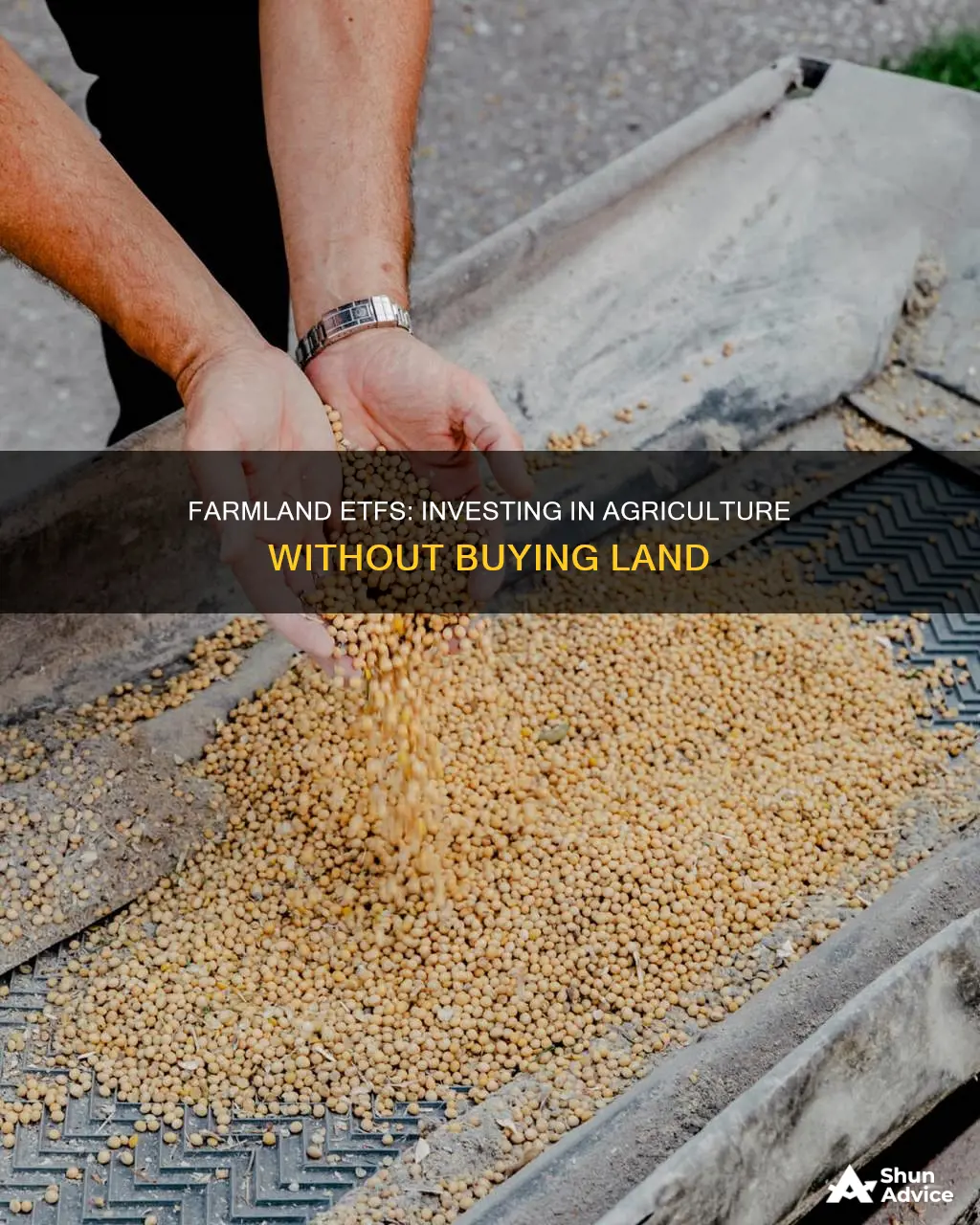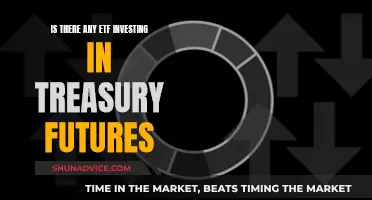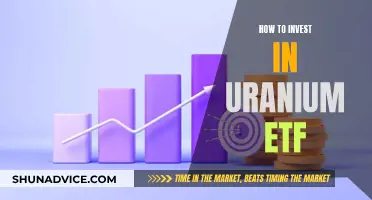
Investing in farmland has become an increasingly attractive prospect for investors looking to diversify their portfolios. While the traditional route of purchasing a farm or pasture remains an option, new opportunities such as ETFs, REITs, and crowdfunding platforms have emerged, making it more accessible for those without a high net worth.
ETFs, or Exchange-Traded Funds, are a popular choice for investors as they provide a diversified exposure to the agriculture sector. The Invesco DB Agriculture ETF (DBA) and the iShares MSCI Global Agriculture Producers ETF (VEGI) are two examples of ETFs that offer investors access to a range of agricultural companies and commodities.
Before investing in farmland ETFs, it is important to consider the management fees and the performance of the index that the fund tracks. Additionally, investors should be aware of the risks associated with the volatile nature of commodities and the impact of factors such as weather conditions, commodity prices, and global economic conditions.
Overall, with the world's population expected to increase and the demand for high-quality food projected to soar, investing in farmland through ETFs can be a strategic move to gain exposure to the agriculture sector and benefit from its potential growth.
| Characteristics | Values |
|---|---|
| Why invest in farmland? | Farmland offers low volatility and a hedge against inflation, boosting both land value and crop income. |
| How can I invest in farmland? | REITs, ETFs, stocks, crowdfunding platforms, and direct purchase are some ways to invest in farmland. |
| REIT examples | Farmland Partners (FPI), Gladstone Land Corporation (LAND) |
| ETF examples | Invesco DB Agriculture ETF (DBA), VanEck Agribusiness ETF (MOO) |
| Crowdfunding platform examples | AcreTrader, FarmTogether, FarmFundr, Steward, Harvest Returns |
What You'll Learn
- Farmland ETFs: Invesco DB Agriculture Fund (DBA) and iShares MSCI Global Agriculture Producers ETF (VEGI)
- Farmland REITs: Farmland Partners (FPI) and Gladstone Land (LAND)
- Farmland stocks: Nutrien (NTR), Archer-Daniels-Midland (ADM), and Corteva (CTVA)
- Crowdfunding platforms: AcreTrader, FarmTogether, and FarmFundr
- Mutual funds: Fidelity Agricultural Productivity Fund (FARMX)

Farmland ETFs: Invesco DB Agriculture Fund (DBA) and iShares MSCI Global Agriculture Producers ETF (VEGI)
Invesco DB Agriculture Fund (DBA)
The Invesco DB Agriculture Fund is an exchange-traded fund (ETF) that offers investors a convenient and cost-effective way to invest in commodity futures, specifically in the agricultural sector. The fund seeks to track the DBIQ Diversified Agriculture Index Excess Return, which is composed of futures contracts on some of the most liquid and widely traded agricultural commodities.
This ETF provides exposure to a basket of different agricultural commodities, including corn, soybeans, wheat, sugar, cocoa, coffee, cotton, and various livestock categories. It is important to note that investing in this ETF comes with a high degree of risk due to the speculative nature of investing in volatile markets.
IShares MSCI Global Agriculture Producers ETF (VEGI)
The iShares MSCI Global Agriculture Producers ETF offers exposure to global agricultural stocks, specifically targeting companies engaged in the business of agriculture. This includes companies that produce fertilizers and agricultural chemicals, farm machinery, and packaged foods and meats.
This ETF provides targeted access to the agriculture sector and can be used to diversify an investment portfolio. It has an expense ratio of 0.39%, which is relatively low compared to similar funds.
Comparison
Both the Invesco DB Agriculture Fund and the iShares MSCI Global Agriculture Producers ETF provide investors with exposure to the agricultural sector. However, they differ in their specific focus and underlying assets. The Invesco DB Agriculture Fund invests in agricultural commodity futures, while the iShares MSCI Global Agriculture Producers ETF focuses on the stocks of companies involved in the agriculture sector.
When considering which ETF to invest in, it is important to review factors such as expense ratios, liquidity, performance history, and the specific types of assets held by the fund. Additionally, investors should be aware of the risks associated with investing in the agricultural sector, including market volatility, weather conditions, and commodity price fluctuations.
A Guide to Investing in CPSE ETFs
You may want to see also

Farmland REITs: Farmland Partners (FPI) and Gladstone Land (LAND)
Farmland Partners Inc. (FPI) and Gladstone Land Corporation (LAND) are two of the most notable publicly traded real estate investment trusts (REITs) that offer investors a chance to invest in the farmland sector.
Farmland Partners (FPI)
Farmland Partners is the largest of the US publicly traded farmland REITs. As of 2019, it had approximately $1.1 billion in assets, including 158,000 acres of farmland in 17 states. It leases this land to over 100 tenants who grow 26 varieties of crops, 57% of which are row crops (corn, soybeans, rice, and cotton) and 42% of which are permanent and specialty crops (almonds, avocados, wine grapes, non-tree fruit, and vegetables).
FPI's net debt-to-equity ratio is considered high at 65.4%, and its interest payments on its debt are not well covered by EBIT (1.1x coverage). Its dividend payments are also not well covered by earnings, with a high payout ratio of 121.5%. However, at its current cash payout ratio (83.9%), FPI's dividend payments are covered by cash flows.
Gladstone Land (LAND)
Gladstone Land is actively acquiring farms across the US and currently owns 111 farms with 86,534 total acres in 10 states valued at $876 million. It primarily focuses on farmland used to grow healthy foods such as fruits, vegetables, and nuts and has a market cap of nearly $600 million.
Gladstone Land has increased its dividend throughout the pandemic, and its dividend payments are well covered by cash flows, with a reasonably low cash payout ratio of 46.1%. However, its dividend yield is a relatively low 1.8%, and its share price is considered richly valued. Additionally, LAND's dividend payments are not well covered by earnings, with a high payout ratio of 197.9%.
Comparison
Both FPI and LAND provide investors with the opportunity to invest in farmland without the need to purchase and manage a farm directly. They offer diversification by giving investors an interest in multiple farms across a wide geographic area and greater liquidity than owning physical farmland.
However, it is important to note that both FPI and LAND have some financial risks, such as high debt levels and coverage issues. Additionally, the dividend yields for both REITs are relatively low compared to other REITs or investment options.
Therefore, investors should carefully consider their investment goals and conduct thorough research before investing in FPI or LAND.
ETFs and Halal Investing: What You Need to Know
You may want to see also

Farmland stocks: Nutrien (NTR), Archer-Daniels-Midland (ADM), and Corteva (CTVA)
Nutrien (NTR)
Headquartered in Saskatoon, Canada, Nutrien is a crop inputs, services, and solutions provider. The company offers potash, nitrogen, phosphate, and sulfate products, as well as financial solutions. It also distributes crop nutrients, crop protection products, seeds, and merchandise products. Nutrien has strong fundamentals, reflected in its POWR Ratings, where it has an overall rating of B, translating to a Buy. The company has a B grade for Value and Quality and is ranked #6 within the industry.
In the third quarter of 2022, Nutrien's sales came in at $8.19 billion, a 35.9% year-over-year increase. Its net earnings increased by 118% year-over-year to $1.58 billion, and its adjusted net earnings per share increased by 81.9% year-over-year to $2.51. For the full year 2022, the company expects its adjusted EBITDA to be between $12.20 billion and $13.20 billion, with adjusted net earnings per share expected to be between $13.25 and $14.50. Analysts anticipate a 7% year-over-year revenue increase in the fourth quarter of 2022, with an 8.3% rise in EPS.
Archer-Daniels-Midland (ADM)
Archer-Daniels-Midland is a $27 billion company and a premier player in agricultural processing, plant and food nutrition, commodities trading, and other aspects of the agriculture industry. ADM is involved in all aspects of agriculture, from growing food and nurturing livestock to transportation, storage, processing, and marketing. The company's customers include farmers, ranchers, and food processors in the US and other regions like Latin America, Canada, and Europe.
ADM is organised into three main segments: Agriculture Services and Seed Oils, Carbohydrate Solutions, and Nutrition. The company produces a wide range of food and food-related products, including vegetable and seed oils, animal feed, food colouring, flavour enhancers, and extracts. It also generates significant revenue through commodity trading and by operating an agriculture futures brokerage. ADM has a strong track record of returning value to shareholders, with a dividend Aristocrats status and 52 consecutive years of annual dividend increases.
ADM's board declared a cash dividend of 40 cents per share in November 2022, marking its 364th consecutive quarterly payment and 91 years of uninterrupted dividends. The company has strong fundamentals, reflected in its POWR Ratings, where it has an overall A rating, translating to a Strong Buy. It has an A grade for Growth and a B for Sentiment and is ranked #2 out of 28 stocks in the Agriculture industry.
In the third quarter of 2022, ADM's revenues increased by 21.4% year-over-year to $24.68 billion. Its adjusted net earnings rose by 91.2% year-over-year to $1.05 billion, and its adjusted EPS saw a 91.8% increase to $1.86. For the fiscal first quarter of 2023, analysts expect a 3.5% year-over-year revenue increase to $24.47 billion, with an EPS of $1.70.
Corteva (CTVA)
Corteva is a $39 billion firm and a world leader in seeds and crop protection products. The company's seed division focuses on developing crop seeds that optimise yields and are more resistant to harsh weather, diseases, and insects, while also using water more efficiently. They also provide farmers with digital software solutions to aid in planting decisions.
The crop protection division manufactures herbicides, soil additives, and advanced nitrogen management fertilisers to protect crops against weeds, insects, and destructive diseases. Morgan Stanley, Morningstar, and CFRA Research are bullish on the stock, with Morgan Stanley giving it an "overweight" rating, and Morningstar and CFRA both rating it as a "buy."
Corteva offers a forward annual dividend of 68 cents per share, resulting in a yield of 1.2%. The company is expected to generate sales of $25.7 billion in 2024, with a growth of about 3% to $26.5 billion in 2025. Earnings per share for 2024 are estimated at $3.76, with a projected increase of 5% to $3.95 for 2025. The stock features an attractive dividend yield of 4.4%.
A Smart Guide to Investing in 3x ETFs
You may want to see also

Crowdfunding platforms: AcreTrader, FarmTogether, and FarmFundr
Crowdfunding platforms have emerged as an alternative way to invest in farmland, allowing investors to buy a small slice of a real farm. This significantly lowers the minimum investment required, making it possible to invest in farmland without needing a large amount of capital.
AcreTrader
AcreTrader is a crowdfunding platform that provides accredited investors with access to pre-vetted U.S. farmland investments. The platform offers a variety of crop options, including row crops, permanent crops, and timberland. AcreTrader also provides investors with due diligence materials, such as soil reports and water rights information, to help them make informed investment decisions. The minimum investment for AcreTrader starts at $10,000.
FarmTogether
FarmTogether is an online marketplace for farmland investing, providing accredited investors with direct access to pre-vetted U.S. farmland investment opportunities. Investors can choose to invest directly in specific farms or in a fund that holds several farm investments, offering diversification across different crops, geographies, and farm managers. Similar to AcreTrader, FarmTogether also provides due diligence materials and regular updates on the performance of each investment. The minimum investment for FarmTogether is $15,000.
FarmFundr
FarmFundr is a unique crowdfunding platform that allows accredited investors to earn income from the farm's harvest, as well as rent or property appreciation. In addition to farmland, FarmFundr also offers investment opportunities in agricultural facilities. The minimum investment for FarmFundr starts at around $10,000.
It is important to note that investing in a single farm through crowdfunding platforms may offer less diversification compared to other investment options like mutual funds or ETFs. Additionally, the holding period for these investments is usually at least three to five years, and there may be challenges in selling shares before this period ends.
Carbon Credits ETF: A Smart Investment Strategy
You may want to see also

Mutual funds: Fidelity Agricultural Productivity Fund (FARMX)
The Fidelity Agricultural Productivity Fund (FARMX) is a mutual fund that offers investors exposure to the agriculture and farming industries. This fund seeks long-term capital growth by investing primarily in equity securities of agricultural productivity companies.
FARMX normally invests at least 80% of its assets in securities of companies across various segments of the agricultural industry. These include farm machinery and equipment, irrigation, agricultural efficiency and services, agricultural science and biotechnology, fertilizers, pesticides, seed manufacturers, crop chemicals, agricultural product processors, and even aquatic farming and livestock services.
By investing in FARMX, you gain access to a diverse range of companies involved in different aspects of agriculture. This diversification can provide a level of risk mitigation compared to investing in a single farm or a specific crop.
In terms of performance, FARMX has returned 11.32% over the past three years. However, it is important to note that the fund has returned -19.85% over the past year, which may be a result of the challenging market conditions and economic climate.
When considering fees, FARMX has an expense ratio of 0.95%, which is below average compared to other funds in the same category. This fund can be an attractive option for investors looking for exposure to the agriculture sector without incurring high costs.
Overall, the Fidelity Agricultural Productivity Fund (FARMX) provides a way for investors to gain diversified exposure to the agriculture industry, offering the potential for long-term capital growth.
ETFs: Understanding Their Status Under the 1940 Act
You may want to see also







